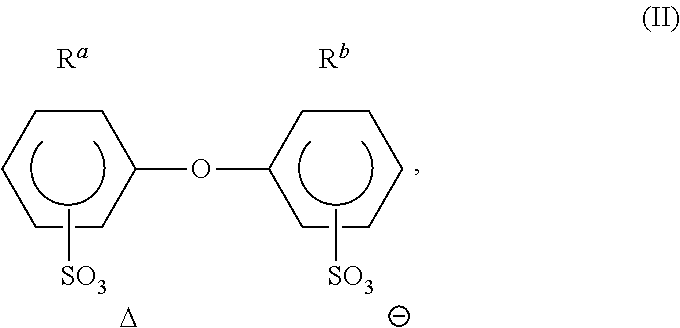Aqueous compositions based on polyalkenamers
a technology of alkenamer and water composition, applied in the field of pneumatic vehicle tires, can solve the problems of oxidation-sensitive materials and tire ingredients, the weight of tires cannot be achieved, and the gas barrier properties are not sufficient, so as to achieve good barrier properties, low permeability, and advantageous mechanical properties
- Summary
- Abstract
- Description
- Claims
- Application Information
AI Technical Summary
Benefits of technology
Problems solved by technology
Method used
Image
Examples
example 1
Production of Polyalkenamer Dispersion 1 (PALK-D1)
[0187]A mixture composed of 107.3 g of deionized water, 13.8 g of an aqueous solution (20 wt %) of a C16 / C18-fatty alcohol polyethoxylate (Lutensol® AT 18 from BASF SE), 2.6 g of n-hexadecane, 8.9 g of norbornene and 43.4 g of cis-cyclooctene were weighed into a 250 ml glass flask with a magnetic stirrer at 20° C. to 25° C. (room temperature) under a nitrogen atmosphere and the mixture was subjected to vigorous stirring for one hour to form a homogeneous monomer macroemulsion. The monomer macroemulsion formed was subsequently homogenized for 10 minutes using a UP 400s ultrasound processor (Sonotrode H7, 100% power). The monomer emulsion obtained was subsequently transferred under a nitrogen atmosphere to a temperature-controllable 500 ml glass flask fitted with a stirrer, thermometer, reflux cooler and feed vessels and heated to 75° C. with stirring. With stirring and while maintaining this temperature, a solution formed from 60 mg o...
example 2
Production of Polyalkenamer Dispersion 2 (PALK-D2)
[0188]Example 2 was carried out similarly to example 1 except that 11.9 g of dicyclopentadiene and 40.5 g of cis-cyclooctene were employed instead of 8.9 g of norbornene and 43.4 g of cis-cyclooctene. The obtained aqueous polymer dispersion had a solids content of 29.9 wt %. Determination revealed the average particle size to be 401 nm, the glass transition temperature of the obtained polymer to be −59° C. and the density to be 0.895 g / cm3.
example 3
Production of Polyalkenamer Dispersion 3 (PALK-D3)
[0189]Example 3 was carried out similarly to example 1 except that 22.9 g of dicyclopentadiene and 29.2 g of cis-cyclooctene were employed instead of 8.9 g of norbornene and 43.4 g of cis-cyclooctene. The obtained aqueous polymer dispersion had a solids content of 29.7 wt %. Determination revealed the average particle size to be 385 nm, the glass transition temperature of the obtained polymer to be −40° C. and the density to be 0.940 g / cm3.
PUM
| Property | Measurement | Unit |
|---|---|---|
| volume-average particle size | aaaaa | aaaaa |
| volume-average particle size | aaaaa | aaaaa |
| wt % | aaaaa | aaaaa |
Abstract
Description
Claims
Application Information
 Login to View More
Login to View More - R&D
- Intellectual Property
- Life Sciences
- Materials
- Tech Scout
- Unparalleled Data Quality
- Higher Quality Content
- 60% Fewer Hallucinations
Browse by: Latest US Patents, China's latest patents, Technical Efficacy Thesaurus, Application Domain, Technology Topic, Popular Technical Reports.
© 2025 PatSnap. All rights reserved.Legal|Privacy policy|Modern Slavery Act Transparency Statement|Sitemap|About US| Contact US: help@patsnap.com

